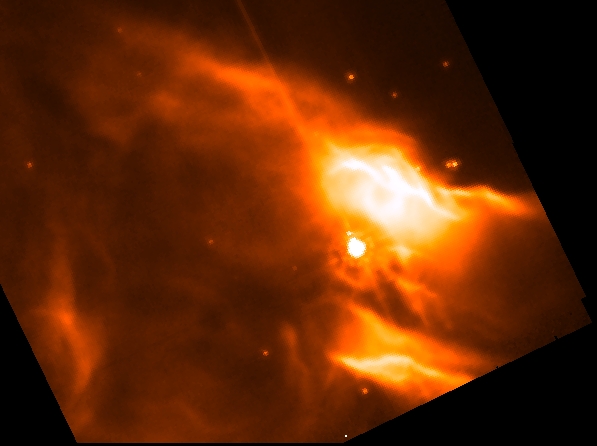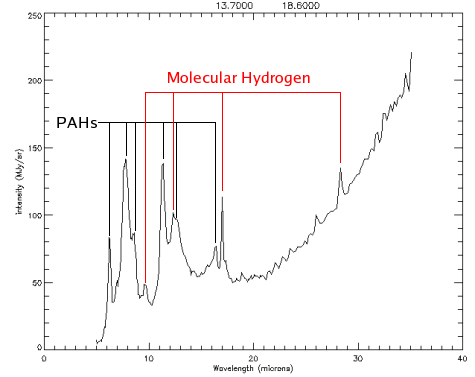| The SPECPDR program |
||||
| Home | Learn
More |
Team |
Publications |
Observations |
This page is under construction!
SPECPDR members securised page
|
|
||||
 Irac Image at 8 microns of the reflection nebula NGC 7023. This image was achieved by Werner et al. |
 The filament seen at the south east (very left) in the IRAC image was investigated using the IRS spectrograph onboard Spitzer, providing the mid-Infrared spectra of this region shown above. The wide and stong bands are due to the emission of Polycyclic Aromatic Hydrocarbons (PAHs). Smaller bands come from the emission of molecular Hydrogen. One of the goal of the SPECPDR program is to learn more on the origin of the continuum seen in this spectrum, which is probaly due to a population of Very Small Grains. |
| Aims
of SPECPDR program: Since the IRAS mission, it is well known that there exists a population of very small particles which are transiently heated by the absorption of single UV photons and emit in the mid-IR range. Polycyclic aromatic hydrocarbons (PAHs) were proposed to account for the well-known Aromatic IR Bands (AIBs) between 3.3 and 12.7 microns. Another component, called very small grains (VSGs; Désert et al. 1990, A&A 237, 215), was introduced as the carrier of the emission in the 25 microns IRAS band. The very small dust particles (PAHs and VSGs) are now considered to play a major role in the physics and chemistry of the interstellar medium. They dominate the heating of interstellar gas through photoelectric effect. They are also suspected to play a major role in the formation of H2 in particular in Photo-Dissociation Regions (PDRs) where UV photons heat the dust making inefficient the physisorption and diffusion of H atoms at the surface of grains, the processes which are usually invoked to form H2 (Habart et al. 2004, A&A 414, 531). In PDRs, the UV field varies as a function of depth within the cloud, and spatial studies give a unique opportunity to follow the evolution of the dust populations and the molecular content as a function of the excitation conditions. Spectro-imagery in the mid-IR (5-16 microns) was possible with the CAM camera on board the Infrared Space Observatory (ISO). A striking result from these observations is the presence of continuum emission in PDRs far from exciting sources (Abergel et al. 2002, A&A 389, 239). This reveals the presence of very small dust particles transiently heated by single UV photons. The band-to-continuum intensity ratio is highly variable showing that the continuum is not carried by PAHs but rather by VSGs. Further analysis of the data (Rapacioli et al. 2005, A&A 429, 193) allowed to extract three spectra : two with band emission only (attributed to PAH cations and neutrals) and one with broad band and continuum emission (attributed to VSGs). The authors found a drop in the VSG emission at the cloud edge which is correlated with the increase in the PAH emission. They proposed that VSGs could be aggregates of PAHs which photoevaporate at the surface of clouds. This work can now continue thanks to the unique spectro-imagery capabilities of the Spitzer Space Telescope ; see Special Issue of ApJ Supp. 154, 2004). This webpage describes the work which is in progress in our team and reports the very first results of the SPECPDR programme. |
|
| Contact:
christine.joblin@cesr.fr Last Update: 05-06-06 |